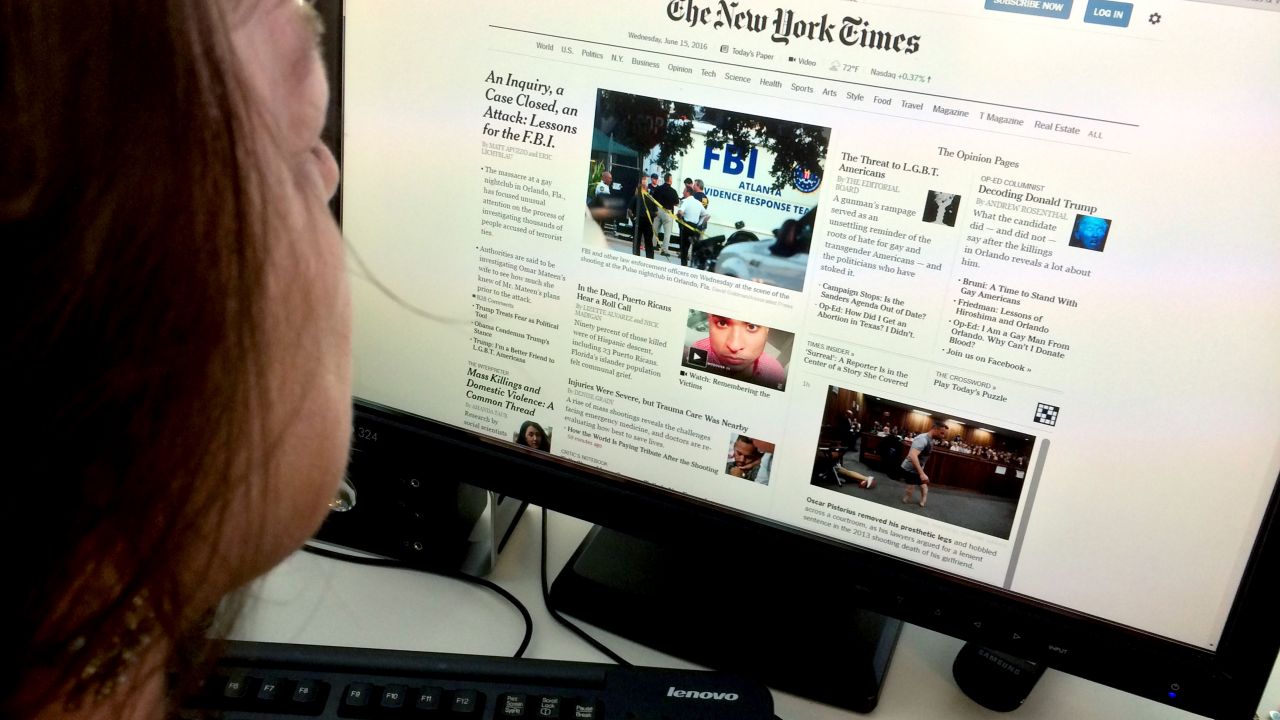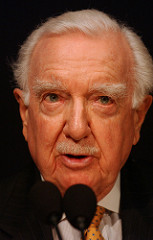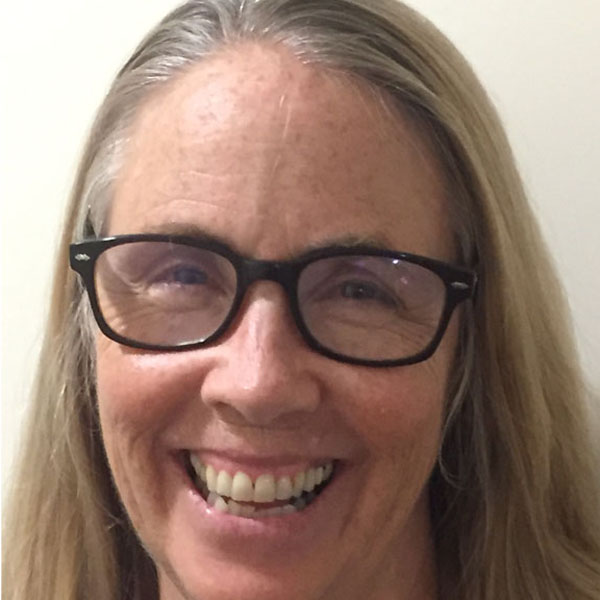
The digital revolution has changed how news is produced, and should also change how it is consumed. (Photo by Karen Bleier/AFP/Getty Images)
Well news fans, to mix metaphors, the ball is now squarely in your court.
“Fake news” is everywhere. For instance:
- Millions voted illegally for Hillary Clinton.
- Protesters were paid to disrupt Trump rallies.
- Pope Francis endorsed Donald Trump.
- And one that turned up just days before the election: Clinton was behind the murder-suicide of an FBI agent involved in her private email debacle.
That’s just a partial list of “stories.” All unequivocally false.
And now, there’s a “fake news” story with real-life consequences: a 28-year-old man fired an assault rifle inside a DC pizzeria recently after reading an outlandish story linking the restaurant and (why not?) Clinton to a child sex-trafficking ring.
There is nothing new about “fake news.” What is different today are the vast social media networks that allow all information — minor or major — to zip around the internet in nanoseconds without regard to truth or importance.
The proliferation of news consumption on social media means Americans are dealing with a firehose of information with little curation or verification. By age 18, according to a 2015 study by the Media Insight Project, 88 percent of millennials get news regularly from Facebook and other social media. According to the Pew Research Center, nearly half of all adults get their news from Facebook, which is currently struggling with how to handle the thorny issue of vetting fake news without violating First Amendment rights.
All of this means that when it comes to determining fact from fake and understanding how one’s own biases affect how news is accessed, processed and shared, the onus in today’s unfiltered media world is irrevocably on the news consumer.
The days when the mainstream news media were trusted gatekeepers who only published or aired deeply reported stories are long over. Each of us must act as our own editor, adopting the skills and taking the time (yes) to determine the real deal. One of the key newsroom axioms to adopt: “If your mother says she loves you, check it out.” In other words, the more you are inclined to believe something, the more you should be skeptical.
The failure to do this is why, no matter how rigorously mainstream news outlets fact-check false stories or scrutinize Donald Trump’s statements, it often doesn’t matter. Liberals and conservatives believe what they want no matter how far-fetched. It’s known as confirmation bias. People search out information that confirms or reinforces what they already think. All too often, they are not open to information that should cause them to question those beliefs.
Research shows that when people are confronted with information that contradicts what they believe, our capacity to reason often shuts down! In 2008, I wrote about confirmation bias for NPR. Nothing has changed. In fact, Americans have gotten more entrenched in their beliefs and their unwillingness to absorb information that contradicts or complicates their beliefs:
Philo Wasburn, a Purdue University sociology professor who co-wrote a book on media bias, knows this well. He told me (in 2008) that research going back to the 1960s shows how difficult, if not impossible, it is to change people’s central core beliefs.
“When people are really committed to some ideological position, especially with politics, even if you present them with empirical evidence that supports the opposite of what they believe, they will reject it,” said Wasburn. “Core beliefs are very, very resistant to change.”
There already are efforts underway to educate the next generation on how to navigate news. The News Literacy Project is a nonprofit dedicated to educating students in middle and high school on how to accurately sniff out the truth. The Center for News Literacy at Stony Brook University works around the world providing tools to develop smarter news consumers.
The need for such education is clear.
A recent Stanford University study found that 82 percent of middle schoolers did not know the difference between a real news story and an ad that clearly stated it was “sponsored content,” basically unedited advertising.
Those results are no surprise to the eight-person team at the News Literacy Project. Alan Miller, a Pulitzer-Prize winning investigative reporter, started it in 2008 after leaving the newsroom to teach teens critical thinking skills. Beginning with schools in New York City and around Washington, DC, the project has expanded to Chicago and Houston. In one New York City school, high school seniors didn’t know Osama bin Laden was dead or that US forces had killed him, according to Miller.
“Students need to be able to understand newsworthiness, sourcing, documentation, fundamental fairness and the aspiration of minimizing bias in a dispassionate search for truth,” wrote Miller in a journal article for the National Council of Social Studies. “They also need to be familiar with concepts of transparency and accountability.”
— Alan Miller, The News Literacy Project
After a presidential election in which “fake news” played such a prominent role, the need for news literacy has never been greater.
“The nature of the presidential campaign combined with the recent disclosures of the prevalence and power of ‘fake news’ have underscored the urgency of teaching news literacy to the next generation,” said Miller. “I wish I could say I was prescient and knew how great the need would be eight years later. But as a prospective donor said, ‘The Zeitgeist has come to you.’ This is our moment.”
In eight years, Miller’s project had worked with several hundred educators and 25,000 students. To dramatically extend its reach nationally, the project in May launched the checkologyTM virtual classroom, a cutting-edge resource that teaches the core skills and concepts for making sense of news and information.
“As many as 675 educators in 41 states and Washington, DC have already registered to use it with more than 62,000 students,” said Miller. “We expect those numbers to grow exponentially.”
While baby boomers now miss the days when CBS’ Walter Cronkite was the most trusted man in America, the problem with “fake news” isn’t going away any time soon. Buzzfeed, which has been a leader in unmasking fake news under the brilliant media whiz Craig Silverman, released a Dec. 6 study showing most Americans who see “fake news” believe it.
As long as money can be made and people can be fooled, “fake news” designed to confuse and raise doubts will flourish. One perpetrator of “fake news” told NPR he earned between $10,000 and $30,000 a month making stuff up to feed voracious partisan appetites — especially, he said, for Trump supporters.
So what can you do?
Slow down. Don’t reflexively pass on something. Start by always employing critical thinking skills. Be skeptical, not cynical. Expect to be fooled. Be vigilant. Don’t make sweeping generalizations. Examine news stories on a case-by-case basis.
A savvy news consumer’s responsibility is to learn how to discern credible information from opinion, sponsored content, “fake news,” viral rumors, clickbait, doctored videos or images and plain old political propaganda. Here are some tips on how:
1. Consider the source.
- Is it a site you are familiar with? If not, check the URL. Watch out for URLs with .co added to what looks like a mainstream news site. For example, many have been fooled by a site that looks like it’s ABC News but it’s not: abcnews.com.co
- Also watch for sites that end in “lo” like Newslo. “These sites take pieces of accurate information and then packaging that information with other false or misleading “facts” (sometimes for the purposes of satire or comedy),” according to Merrimack College Professor Melissa Zimdars, who has made a specialty of studying “fake news.”
- Read the “About Us” section. Does it seem credible? It too may be made up.
- Is there a way to contact the news organization?
- Does it have a link to its editorial standards? Like PBS does.
- How credible does the website look? Is it screaming ALL-CAPS? Are there distracting gizmos for you to click on and win $10,000? Exit, immediately.
2. Read beyond the headlines.
Too often we read an outrageous headline that confirms our biases and quickly pass it on. Don’t. Read deeper into the story and ask:
- How many sources are there? Is there documentation or links to back up the claim? Could you independently verify the contents? In most mainstream media stories, people are quoted by name, title and where they work (although sometimes they are quoted anonymously), and there are links to reports or court documents.
- Search the names of people, places or titles in a story. For example, the false story about Clinton being behind an FBI agent’s murder-suicide, said it took place in Walkerville, Maryland. There is no such place. There is a WalkerSville. Tricky.
- Check out a far-fetched quote by copying and pasting it into a search engine. Anyone else have that?
- Check out the author’s name. Search it or click on it. Has he or she written anything else? Is it credible?
- Is there any context included in the story? Does it seem fair? Are there opposing points of view?
- Drill down to find out who is behind the site —especially if it’s a contentious issue.
3. Check the date.
Too many times, a story is recycled with a new exaggerated headline. You’d be surprised how many times people die. In July, I got an email that famous journalist Helen Thomas had died. I started to forward it but something didn’t seem right. Why? She had died three years ago.
4. Double check suspicious photos.
This is fairly easy to do by right-clicking on a image and the doing a Google search. Photos of Hillary Clinton stumbling back in February were recycled closer to the election to give the impression she was sick.
Several other helpful sites can assist:
5. Check your biases.
Know your own biases. Try taking Harvard University’s Project Implicit bias test.
6. Learn from a wide variety of sources.
- If you lean left, watch Fox News, read the Wall Street Journal editorial page, Weekly Standard, National Review and Reason magazine. Be aware and skeptical of what’s being said on Alex Jones, Rush Limbaugh and Breitbart.
- If you lean right, tune in Rachel Maddow on MSNBC. Pay attention to Amy Goodman’s Democracy Now! While the left doesn’t appear to have as many well-established (and popular) conspiracy-theory, faux-news peddlers, the same goes for what you might hear on the other side. Be skeptical: If it sounds too good to be true, it bears checking out.
- Or watch more middle-of-the-road news on PBS’ NewsHour. Listen to NPR.
- Check out Media Matters, which monitors conservative media and the Media Research Center, which monitors the mainstream media.
If you walk away with one useful piece of information, always ask this question: How do you know that?
Do it all with a healthy skepticism. Every story you agree with isn’t necessarily so. Every story you disagree with is not necessarily biased either. Be open to views you don’t agree with.
Verify, verify, verify. And keep honing your skills.
Further reading:
- The News Literacy Project’s How to Spot Fake News
- Merrimack College Professor Melissa Zimdars’ “False, Misleading, Clickbait-y, and/or Satirical ‘News’ Sources“
- Snopes.com
- Politifact.com
- Factcheck.org’s How to Spot Fake News
- Craig Silverman’s Five Telltale Signs of an Online Hoax
- First Draft News.com provides an excellent guide to navigating the news online.
Note: This story has been edited to differentiate between good and questionable right-wing and left-wing news sources.





